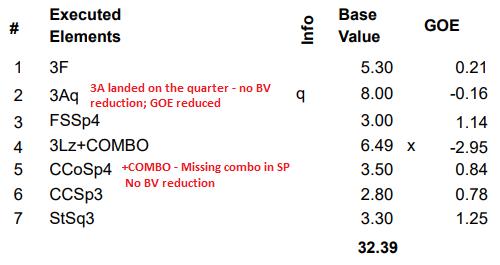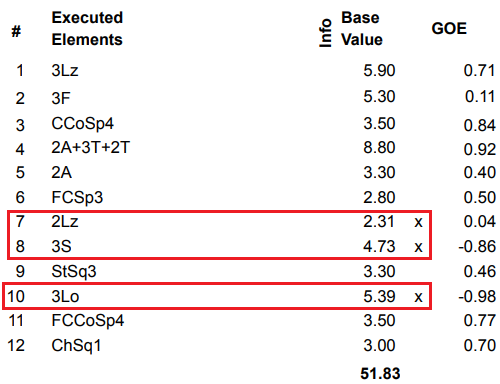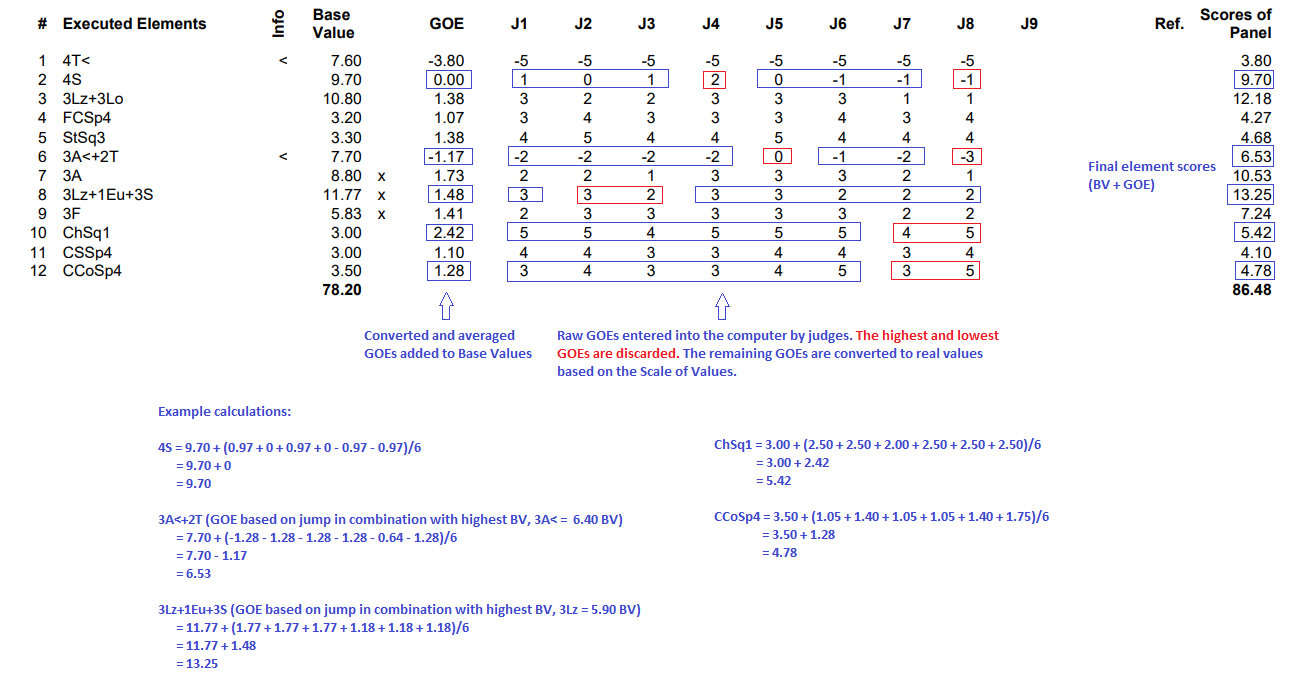
Introduction to the ISU Judging System
Introduction to the ISU Judging System
This guide is an overview of the ISU Judging System (IJS) for scoring figure skating competitions. This guide will focus on senior-level singles skating, but will occasionally mention pairs, ice dance, and junior level skating. It is up to date with the rule changes accepted at the 2024 ISU Congress.
More introduction to skating guides are available here. Please do not reproduce any part of this guide without permission.
LAST UPDATED: Aug. 20, 2024
Table of Contents:
Skating competitions consist of two segments, the short program and the free skate (rhythm dance and free dance in ice dance). Skaters receive a score for each segment and the skater with the highest total score wins the competition. A detailed breakdown of skaters’ scores is uploaded on the International Skating Union (ISU) or competition website after each competition. These documents are called protocols. Here is an example of a senior woman’s short program protocol:
There are two parts of a Total Segment Score (TSS): the Technical Element Score (TES) and Program Component Score (PCS). The Total Segment Score for a program is the sum of the TES and PCS. TES is the score assigned to technical elements included in a program - jumps, spins, step sequences, etc. - and how well those elements are executed. PCS evaluates other parts of the program as a whole. There are three components of PCS: Composition, Presentation, and Skating Skills.
READING PROTOCOLS: ELEMENT ABBREVIATIONS
There are many types of technical elements performed in figure skating programs. Major elements in singles skating are explained below. Please see this post for more information on elements in pair skating and ice dance.
Jumps:
A: Axel
F: Flip
Lo: Loop
Lz: Lutz
S: Salchow
T: Toe loop
Eu: Euler (always appears as 1Eu)
The number in front of the abbreviation refers to the number of rotations in a jump (eg. a 4T is a quadruple toe loop, 3Lz is a triple lutz). Jumps performed in combination, in which one jump immediately follows another, have a “+” sign between the abbreviations (eg. 4T+3T is a quad toe-triple toe combination, 3Lz+1Eu+3S is a triple lutz-euler-triple salchow combination). In a jump sequence, the landing of one jump is not the takeoff of the next, and a +SEQ symbol will appear in the protocol (eg. 3F+2A+SEQ is a triple flip-double axel sequence). In both singles and pair skating, the second or third jump in a sequence can only be an axel. For more information on jumps, see this post.
Spins:
CSp: Camel spin
LSp: Layback spin
SSp: Sit spin
USp: Upright spin
CoSp: Combination spin
“F” before one of these indicates a flying spin
“C” before one of these indicates a change-foot spin
The number following the spin abbreviation indicates the level of the spin. Levels range from B (base) to 4, with 4 being the highest/most difficult. For example, a FCCSp4 would be a level 4 flying change-foot camel spin. Spin levels are assigned based on various criteria, such as the number of revolutions and changes in position.
Step sequences:
As with spins, the step sequence (StSq) has levels ranging from B to 4, with 4 being the highest/most difficult. Some older abbreviations for circular (CiSt), straight-line (SlSt), and serpentine (SeSt) step sequences are no longer used in protocols, but skaters can still use any of these patterns for their step sequences. Criteria used to judge levels include ice coverage, number of difficult turns and steps, etc.
Choreographic sequences:
The choreographic sequence (ChSq) was introduced in the 2012-13 season. It has a designated level of 1 and does not require steps and turns like a step sequence. The choreographic sequence can include various choreographic moves that highlight the music of the program.
Here is an example protocol summarizing the basic element abbreviations:
TECHNICAL ELEMENT SCORE
BASE VALUES:
Each element in a program has a base value: It is worth a certain amount of points, designated by the ISU.
Jumps are worth the most points out of all the elements in singles skating. The “harder” the jump, the higher its base value. For jumps with the same number of rotations, the order from greatest base value to least is: axel, lutz, flip, loop, salchow, toe loop. (However, skaters have different preferences for jumps, so this ranking of difficulty is somewhat subjective.) A triple axel is worth more than a triple loop, a double flip is worth more than a double toe loop, and so on. The base value of a jump combination or sequence is the sum of the base values of the jumps in the combination or sequence.
Base values for spins and step sequences are based on their level. A level 1 spin is worth less than a level 4 spin, a level 2 step sequence is worth less than a level 3 step sequence, and so on.
Some mistakes can reduce an element's base value:
Pops: If a skater pops a jump - opens up too early in the air without doing the planned number of rotations - they will only receive credit for however many rotations were actually completed. Pops are one of the most costly mistakes skaters can make; doing a double or single jump instead of a triple or quad can drastically lower a skater's base value. In pairs skating, if one partner pops a side-by-side jump and the other partner doesn't, the base value of the pop is applied to the entire jump attempt.
Underrotations: The base value of a jump can be reduced by not fully rotating the jump, resulting in either an underrotation, marked by a “<“ symbol next to the jump on the protocol, or a downgrade, marked by a “<<“ symbol. Jumps that are between a quarter and a half rotation short are called underrotated, and jumps that are short by half a rotation or more are downgraded a full rotation. For example, a downgraded 3Lz would have the same base value as a 2Lz. Underrotations can be costly and too many of them can kill a skater’s score, even if they appear to land all of their jumps at first glance.
In the 2020-21 season, the ISU introduced the "q" symbol - jumps that are landed exactly a quarter rotation short. Jumps that are marked with "q" do not receive a base value reduction, but the Grade of Execution of the jump is reduced.
Edge calls: If a flip or lutz jump receives an edge call (an error on takeoff; marked “e” on the protocol), its base value will be reduced. If a flip or lutz receives an edge call as well as an underrotation, its base value will be reduced even further. A “!” symbol next to a flip or lutz indicates a warning and means that the edge is unclear, but the base value of the jump will not be reduced, only the Grade of Execution. For more information regarding takeoff edges and how to tell the jumps apart, see this post.
Repeated jump not in combination: If a solo triple or quad jump is repeated in a free skate and the second jump is not in a combination, a "+REP" symbol will appear next to the second jump and its base value will be reduced to 70% of the original.
Failed spin requirements: If a spin does not meet certain requirements (usually involving number of rotations in a position), a “V” symbol will appear at the end of the spin abbreviation on the protocol, and the base value of that spin will be reduced.
Underrotations, edge calls, and spin/step levels are all determined by the technical panel, a group of officials at each competition whose job is to identify elements performed in a program. Anything regarding base values and the validity of elements is determined by the technical panel.
Here are example protocols showing errors that can decrease the base values of jumps and spins:
PROGRAM LAYOUT:
Senior program lengths:
Short programs: 2 min, 40-50 sec
Free programs: 4 min, +/- 10 sec
Required elements for senior singles short programs:
3 jumping passes
3 spins
1 step sequence
Required elements for senior singles free programs:
7 jumping passes
3 spins
1 step sequence
1 choreographic sequence
For more information on required elements in other disciplines, please see this post.
In both the singles short and free programs, performing a jump in the second half of a program increases the base value of the jump by 10%. In the protocol, this is marked by an “x” symbol next to the base value. The bonus rule resulted in many skaters “backloading” their programs - performing more jumps in the second half in order to gain points. Starting from the 2018-19 season, only the last jumping pass in the short program and last three jumping passes in the free skate may receive bonuses if they are performed in the second half of the program.
The following protocol shows 3 backloaded jumping passes in a woman’s free skate.
Invalid elements:
Invalid elements break the rules of program layouts and/or types of elements allowed. They are marked by an asterix (*) on the protocol and receive zero points. An element can be invalidated in many ways. For example, only two of each type of double, triple or quad jump are allowed in a free program. So, if a skater performs 3 triple flips in a free program, the third flip receives zero points. Breaking jump layout rules is colloquially referred to as “Zayaking”. For more information on invalid jump elements, see this post. Spins and other elements can also be invalidated if the skater fails to fulfill basic requirements.
GRADE OF EXECUTION:
The base value of an element defines how many points it is worth, but Grade of Execution (GOE) evaluates how well an element is executed. Judges award GOEs from -5 to +5 in increments of 1. A well-executed element receives positive GOE, while a badly-executed element receives negative GOE. There are various criteria for assigning GOEs. The final GOE that a judge assigns to an element is a consideration of all the good and bad qualities of the element. Errors such as falls, messy jump landings, and wobbly spins cause a negative shift in the GOE, but good qualities of the element (height and distance of a jump, good air position, difficult entry, good speed in a spin, etc.) can somewhat offset the negative GOE of the errors.
While the technical panel deals with base values, GOEs are awarded by judges. At major ISU competitions, there are 7 to 9 judges, and the highest and lowest judges’ GOE scores are discarded while the remaining scores are used to calculate the overall GOE. Note that the "raw" +/-1 to +/-5 given by the judges are not directly added or subtracted from the base value of an element. Each GOE adds or subtracts a fraction of the base value of the element in question. The “translation” is defined in the ISU Scale of Values. For most (but not all) elements, 1 GOE translates to 10% of the element’s base value.
In jump combinations and sequences, the GOE is based on the base value of the most valuable jump in the combination or sequence, after taking underrotations and edge calls into account.
Here is an example protocol showing how GOEs are calculated.
PROGRAM COMPONENT SCORE
The Program Component Score is often confused for an “artistry” score, but the definition is not so simple. There are three components to PCS, as follows:
Skating Skills (SK): “The ability of the skater to execute the skating repertoire of steps, turns and skating movements with blade and body control.”
Presentation (PR): “The demonstration of engagement, commitment and involvement based on an understanding of the music and composition.”
Composition (CO): “The intentional, developed and/or original arrangement of the repertoire of all types of movements into a meaningful whole according to the principles of proportion, unity, space, pattern and musical structure.”
Prior to the 2022-23 season, PCS also included the Transitions and Interpretation categories.
PCS are awarded by judges in increments of 0.25 from 0.25 to 10. The highest and lowest scores in each category are discarded and the remaining scores are then averaged. The sum of the average scores is multiplied by a factor to give the final PCS. These factors vary by program and discipline:
Men’s SP: 1.67
Men’s FS: 3.33
Women’s & Pairs' SP: 1.33
Women’s & Pairs' FS: 2.67
Rhythm Dance: 1.33
Free Dance: 2.00
These factors are used to balance TES and PCS so that they affect the total score more or less equally. The factors in women’s skating are lower than in men’s because women tend to have lower TES than men. This is why women’s PCS appear to be lower than men’s; the factor is smaller, but the values given out by the judges might not be.
The maximum possible PCS in each discipline:
Men’s SP: 50.00
Men’s FS: 100.00
Women & Pairs’ SP: 40.00
Women & Pairs’ FS: 80.00
Rhythm Dance: 40.00
Free Dance: 60.00
The example protocol below shows how PCS is calculated, using a man’s free skate.
DEDUCTIONS
Deductions are applied to the total score after TES and PCS have been determined. Deductions - usually of 1 point, sometimes more - can be given for a variety of reasons, including, but not limited to:
Falls: In senior singles skating, the first two falls in a program receive deductions of 1 point each, the third and fourth falls receive deductions of 2 points each, and any further falls receive deductions of 3 points each. (This rule was introduced in the 2016-17 season.) In all other disciplines, and in junior singles skating, falls receive deductions of 1 point each. If both partners in a pairs/dance team fall, they will each receive a 1-point deduction.
Costume violations, including part of a costume falling onto the ice
Music or time violations
Interruption of the program
Taking more than the allowed amount of time to get into starting positions
Illegal elements
Depending on the problem, sometimes the technical panel or judges will vote on whether a deduction should be applied.
TIES
While ties in scores are not common under IJS, they have happened a number of times. If there is a tie in the total score between two skaters, the skater with the higher free skate score wins the tiebreak. If there is a tie in the short program, the skater with the higher TES wins the tiebreak, and if there is a tie in the free skate, the skater with the higher PCS wins.
This post gives a general overview of the scoring system, but there is much more information that isn't covered here. If you’re interested in learning more, please take a look at the ISU website. Many ISU documents are available here: singles & pairs, ice dance. The ISU Development Project has also created videos explaining the GOE system for singles, pairs, and ice dance.







